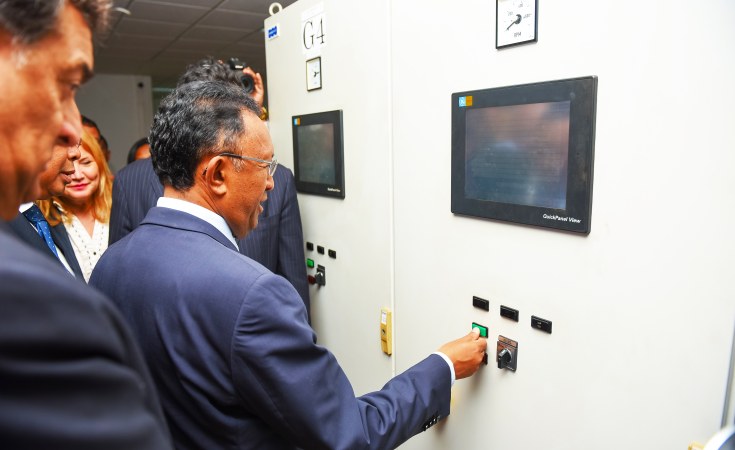Antananarivo — Your Excellency President Hery Rajaonarimampianina ; Honorable Ministers; Mr. Ambassador of the United States to Madagascar ; Chairman Goodlatte and Honorable Members of the United States Congress ; All protocols observed.
Thank you so much for giving us your valuable time today, it is a pleasure to have you at the inauguration of this important facility.
Madagascar is an island nation that is larger than France. It has a population of around 24 million people and yet it has no electricity grid. So outside of the capital most of the power is supplied by very expensive diesel generators.
Two years ago I came here and I was taken aback by the lack of infrastructure in the power sector. I was also enormously impressed by the vision of President and his determination to urgently improve the situation. What you see here today is the fruit of bold initiatives started by the government at that time. This power plant was in a state of dilapidation, producing only 2 MW and there were constant black outs in Antananarivo. Through tough negotiations with Symbion Jirama secured an agreement for us to invest in the rehabilitation of the plant and operate it for 20 years at what is today the lowest cost of any private generator in the country. Symbion is very proud to be able to supply the government of Madagascar with such affordable electricity. The cost is 3 cents per Kwh, exclusive of the cost of fuel which is supplied to us by Jirama.
Mandroseza has a total installed capacity of 40MW. To many of you that may not seem like a lot of power, but in a city where the maximum demand during the evening peak is only 228 MW and the entire country is only 350MW this additional power will have a huge impact.
The plant runs on Heavy Fuel Oil (HFO), sometimes knows as Residual Fuel Oil (RFO). This fuel has a high viscosity and is almost tar-like in it’s raw state. But, after being heated up to 65 degrees C and channeled through separators to remove impurities it drives the engines of the generators to deliver reliable and low cost power. HFO is considerably lower in cost than diesel which makes up a large amount of Madagascar’s generation capacity. The consequence of using HFO is reduced fuel expenditures by the power utility Jirama.
HFO is an indigenous natural resource in Madagascar and it is available from an oilfield near Tsimiroro known as Madagscar Oil, about 150kms from the west coast. We have already tested the crude oil from that field and the plant ran perfectly on it. This is good news for the country because the local fuel should be cheaper than imported HFO, bringing about even greater savings.
Some of you might be asking why in this day and age we have invested in a fossil fuel power plant as opposed to renewable electricity. The answer is simple and it is because the only renewable energy that can possibly supply 24/7 (known as base load) power is hydro (water) and it take years to build new hydro-electric power plants. Even then, the risk of seasonality exists and when there is poor rainfall the hydropower system can be disabled. This happens regularly in Madagascar and elsewhere in Africa, with existing hydropower systems.
Today, what this country most needs is sufficient capacity to meet it’s current demand and the ability to scale up as suppressed demand is unlocked. Solar is a wonderful renewable, as is wind power but solar does not work at night and wind can be intermittent. This means that there must still be sufficient power available to take over when renewables are not working. That is why an energy mix is important and why thermal energy cannot yet be ignored.
Africa needs electricity.
Symbion supports the development of both fossil fuel and renewable energy sources and we will be pleased to invest more in these areas if we are given the opportunity. Symbion works to the international environmental standards set out by the International Finance Corporation (IFC) and all our plants have rigorous emission controls. Climate change is real and we ensure that we are compliant with all regulations in that regard.
Before I handover to the Ambassador I’d like to say a few thank-you’s : Mr. President, thank you for believing in Symbion. Presidential Advisors Eric and Hyacinthe. The US Ambassador and US Embassy staff for wonderful support throughout. Zouzar Bouka – our great local partner. Richard Westbury & Ted Kalborg – my mentors, partners and friends. Eytan Stibbe & Sandy Oppenheim - great Symbion investors, partners and friends. Zelda Weitz, Liubym Gerasymenko and Ian Mcann my colleagues in New York. Mirela Comaniciu – Symbion GM. Longest serving employee of Symbion. (please stand). Norby Narceda & Tovo and the entire incredible Symbion Mandroseza (ask to stand). We have the greatest respect for you. Thank you so much.



